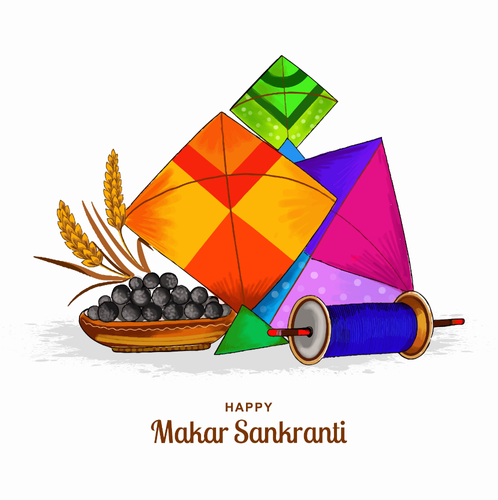
Makar Sankranti is one of the most significant and widely celebrated festivals in India, marking the transition of the Sun into the zodiac sign of Capricorn (Makara Rashi). This festival, typically observed on January 14th, signifies the end of the winter solstice and the beginning of longer days. It is a harvest festival celebrated with great enthusiasm across different states, each with its unique traditions and customs. Makar Sankranti is known by various names in different regions, such as Pongal in Tamil Nadu, Uttarayan in Gujarat, Magh Bihu in Assam, and Lohri in Punjab.
Historical and Mythological Significance
Makar Sankranti has deep historical and mythological roots:
Transition of the Sun: The festival marks the Sun’s northward journey (Uttarayan) when it enters Capricorn, signifying a change in seasons. This transition is considered highly auspicious as it symbolizes the Sun moving towards longer and warmer days, bringing in the harvest season.
Mythological Tales: One popular legend associated with Makar Sankranti is the story of Bhishma Pitamah from the Mahabharata. Bhishma, who had the boon of choosing the time of his death, chose to leave his mortal body during the period of Uttarayan, believing it to be the most auspicious time for attaining liberation (Moksha).
Harvest Festival: As a harvest festival, Makar Sankranti signifies the end of the winter harvest season and the beginning of a new agricultural cycle. Farmers celebrate this period with joy and gratitude, offering prayers and thanks for the bountiful harvest.
Celebrations Across India
Makar Sankranti is celebrated with diverse customs and traditions across different states of India, reflecting the country’s rich cultural heritage:
Pongal in Tamil Nadu: Pongal is a four-day festival celebrated in Tamil Nadu. The first day, Bhogi, is dedicated to cleaning and discarding old items. The second day, Thai Pongal, involves the preparation of the traditional dish ‘Pongal,’ made from freshly harvested rice, milk, and jaggery. The third day, Mattu Pongal, is dedicated to cattle, acknowledging their role in agriculture. The final day, Kaanum Pongal, is a time for family reunions and social gatherings.
Uttarayan in Gujarat: In Gujarat, Makar Sankranti is celebrated as Uttarayan, famous for its kite-flying tradition. The sky is filled with colorful kites, and people engage in friendly competitions. Special dishes like Undhiyu (a mixed vegetable dish) and Chikki (a sweet made of jaggery and sesame seeds) are prepared and enjoyed.
Magh Bihu in Assam: In Assam, the festival is known as Magh Bihu or Bhogali Bihu, celebrating the end of the harvesting season. The festivities begin on Uruka, the eve of Bihu, with community feasts and bonfires. Traditional games, music, and dance mark the celebrations, and special dishes like Pitha (rice cakes) and Laru (sweets) are prepared.
Lohri in Punjab: Lohri, celebrated a day before Makar Sankranti, is a significant festival in Punjab, marking the end of winter and the arrival of longer days. People gather around bonfires, sing traditional songs, and perform the Bhangra dance. Sesame seeds, jaggery, and popcorn are thrown into the fire as offerings.
Khichdi in Uttar Pradesh and Bihar: In Uttar Pradesh and Bihar, Makar Sankranti is known as Khichdi. Devotees take a dip in the holy rivers, particularly the Ganges, and offer prayers. The festival is characterized by the preparation of Khichdi, a dish made of rice and lentils, which is offered to the deities and shared with family and friends.
Rituals and Customs
Makar Sankranti is marked by various rituals and customs that highlight the cultural diversity and spiritual significance of the festival:
Holy Baths: Taking a holy dip in rivers, especially the Ganges, is a common practice on Makar Sankranti. This ritual is believed to purify the soul and wash away sins. Pilgrims from all over the country visit sacred riverbanks to participate in this auspicious activity.
Offering Prayers and Donations: Devotees offer prayers to the Sun God, thanking him for the bountiful harvest and seeking his blessings for prosperity and well-being. Donations of food, clothes, and other essentials to the needy are considered highly meritorious.
Special Delicacies: Makar Sankranti is celebrated with the preparation of various traditional dishes made from the new harvest. Sweets made from sesame seeds and jaggery, such as tilgul and tilkut, are widely prepared and distributed among friends and family.
Kite Flying: In many parts of India, particularly in Gujarat and Maharashtra, kite flying is a major attraction during Makar Sankranti. The clear blue sky is dotted with colorful kites of various shapes and sizes, symbolizing freedom and joy.
Cultural Performances: Traditional dances, songs, and cultural performances are an integral part of the celebrations. In different regions, people perform folk dances like Bhangra, Garba, and Dandiya, adding to the festive spirit.
Spiritual and Astrological Significance
Makar Sankranti holds immense spiritual and astrological significance:
Auspicious Time: The transition of the Sun into Capricorn is considered highly auspicious, as it marks the beginning of the Sun’s northward journey. This period is believed to be conducive to spiritual practices and rituals, enhancing their efficacy.
Positive Energy: The festival is associated with the flow of positive energy and the dispelling of darkness and negativity. Devotees believe that the Sun’s movement towards the northern hemisphere brings warmth, light, and positive vibrations.
Balance and Harmony: Makar Sankranti symbolizes the balance between nature and human life. It signifies the harmony between the celestial bodies and the Earth, highlighting the interconnectedness of all life forms.
Renewal and Growth: The festival marks the end of the old and the beginning of the new, symbolizing renewal and growth. It encourages individuals to let go of past negativities and embrace new opportunities with hope and optimism.
Environmental and Social Impact
Makar Sankranti also has a significant environmental and social impact:
Agricultural Importance: As a harvest festival, Makar Sankranti highlights the importance of agriculture in Indian society. It is a time to honor and celebrate the hard work of farmers, acknowledging their crucial role in sustaining the community.
Community Bonding: The festival fosters community bonding and social harmony. People come together to celebrate, share meals, and participate in cultural activities, strengthening social ties and promoting unity.
Environmental Awareness: The rituals and customs associated with Makar Sankranti often emphasize the importance of nature and the environment. For instance, the worship of the Sun God and the acknowledgment of cattle’s role in agriculture highlight the interdependence of human life and nature.
Sustainable Practices: Traditional practices during Makar Sankranti, such as preparing homemade sweets and using natural ingredients, promote sustainability and eco-friendly living. The festival encourages the use of locally sourced produce and traditional cooking methods.
Modern-Day Celebrations
In modern times, Makar Sankranti continues to be celebrated with the same fervor and enthusiasm, albeit with some contemporary influences:
Social Media and Technology: The advent of social media and technology has transformed the way people celebrate Makar Sankranti. Greetings and wishes are exchanged online, and live streaming of rituals and cultural performances allows people to participate virtually.
Urban Celebrations: In urban areas, the festival is celebrated in community centers and housing societies, where residents come together for collective celebrations. Kite flying events, cooking competitions, and cultural programs are organized, adding a modern touch to traditional festivities.
Cultural Exchange: Makar Sankranti has also become a platform for cultural exchange, where people from different regions and communities share their unique traditions and customs. This promotes cultural understanding and appreciation among diverse groups.
Environmental Initiatives: With increasing awareness about environmental issues, many communities have adopted eco-friendly practices during Makar Sankranti. Initiatives like using biodegradable materials for kite making and promoting organic farming are gaining popularity.
Conclusion
Makar Sankranti is a vibrant and joyous festival that celebrates the bounties of nature, the hard work of farmers, and the warmth of human relationships. Its diverse customs and traditions reflect the rich cultural tapestry of India, while its spiritual significance underscores the timeless values of renewal, balance, and harmony.
As people come together to celebrate this festival, they not only honor their heritage and traditions but also embrace the universal themes of gratitude, unity, and hope. Makar Sankranti serves as a reminder of the interconnectedness of life and the importance of living in harmony with nature and each other.
